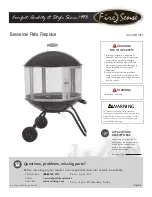
5 Installation
uniSTOR GB
10
Example
22 mm discharge pipe having 4 elbows and a length of
7 m from the tundish to the discharge point:
Resistance for 4 elbows
at 0.8 m each
=
3.2 m
Resistance of discharge pipe =
7.0 m
Total Resistance
= 10.2 m
The total resistance of the discharge pipework is
greater than the maximum allowed for 22 mm
pipework (9 m). Therefore calculate the next largest
size.
28 mm discharge pipe with 4 elbows and 7 m length
from tundish to discharge point.
Resistance for 4 elbows
at 1.0 m each
=
4.0 m
Resistance of discharge pipe =
7.0 m
Total Resistance
=
11.0 m
The total resistance of the discharge pipework is less
than the maximum allowed for 28 mm pipework
(18 m) therefore the discharge pipework size is
acceptable.
Fig. 2 Typical discharge pipe arrangement
Under fault conditions, the discharge warning pipe can
emit water at near boiling temperature. Ensure the
discharge pipe terminates at a safe position where there
is no risk of contact with hot water by persons in or
about the building (save and visible).
A suitable position for the discharge point is ideally
below a fixed grating and above the water seal in a
trapped gully. Downward discharges at low level, i. e. up
to 100 mm above external surfaces such as car parks,
hard standings, grassed areas, etc. are acceptable
metal discharge pipe from
temperature relief valve to tundish
metal discharge pipe from tundish
with continuous fall.
tundish
Discharge below
fixed grating
fixed grating
trapped gully
safety
device
(e.g.
temperature
relief valve)
500 mm
maximum
300 mm
minimum
providing that where children may play or otherwise
come into contact with discharges a wire cage or similar
guard is positioned to prevent contact, whilst
maintaining visibility.
Do not fit any valves or taps to the discharge pipework.
Ensure the pipework has at least 1:200 fall continuously
from the tundish to the discharge point.
The discharge pipe from the pressure relief valve of the
Vaillant boiler may be teed-into the discharge pipework
from the uniSTOR downstream of the tundish in the
horizontal pipework.
5.1.4.1 High Level Termination
Providing that the point of termination is such that
persons in or around the building will not be endangered
should discharge take place, the method of termination
shown in fig. 3 is satisfactory. Examples of points to
consider when deciding whether a location for the high
level discharge is suitable are:
– The possibility, taking into account wind effect, that
someone may be in the path of the water being
discharged and if so, whether the temperature of the
discharge water will have been sufficiently reduced to
not be dangerous. Thermal conductivity of the
structure’s surface, climatic conditions and location
and orientation of the discharge pipe may or may not
have an effect on reducing the temperature of the
discharge water.
– The location of windows and similar openings.
– The likelihood of a pram being left beneath the point
of discharge.
– The ability of the structures surface to withstand near
boiling water.
– The possibility of ice formation if water is discharged
onto pedestrian walkways.
Fig. 3 High level termination
300 mm
minimum
tundish
discharge pipe
metal hopper
head
0020005468_02_GB_042008.qxd 16.04.2008 14:17 Uhr Seite 10
Содержание uniSTOR VIH GB SERIES
Страница 26: ......
Страница 27: ......
Страница 28: ...0020005468_02 GB 042008 Subject to alteration Printed in Germany...











































